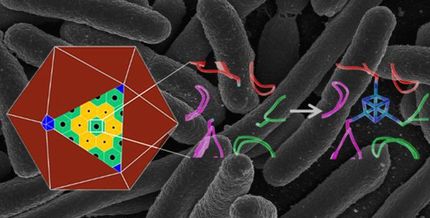Newly discovered 'design rule' brings nature-inspired nanostructures one step closer
Advertisement
Scientists aspire to build nanostructures that mimic the complexity and function of nature's proteins, but are made of durable and synthetic materials. These microscopic widgets could be customized into incredibly sensitive chemical detectors or long-lasting catalysts, to name a few possible applications.

Ranjan Mannige, Berkeley Lab
But as with any craft that requires extreme precision, researchers must first learn how to finesse the materials they'll use to build these structures. A discovery by scientists from the Department of Energy's Lawrence Berkeley National Laboratory (Berkeley Lab) is a big step in this direction.
The scientists discovered a design rule that enables a recently created material to exist. The material is a peptoid nanosheet. It's a flat structure only two molecules thick, and it's composed of peptoids, which are synthetic polymers closely related to protein-forming peptides.
The design rule controls the way in which polymers adjoin to form the backbones that run the length of nanosheets. Surprisingly, these molecules link together in a counter-rotating pattern not seen in nature. This pattern allows the backbones to remain linear and untwisted, a trait that makes peptoid nanosheets larger and flatter than any biological structure.
The Berkeley Lab scientists say this never-before-seen design rule could be used to piece together complex nanosheet structures and other peptoid assemblies such as nanotubes and crystalline solids.
What's more, they discovered it by combining computer simulations with x-ray scattering and imaging methods to determine, for the first time, the atomic-resolution structure of peptoid nanosheets.
"This research suggests new ways to design biomimetic structures," says Steve Whitelam, a co-corresponding author of the Nature paper. "We can begin thinking about using design principles other than those nature offers."
Whitelam is a staff scientist in the Theory Facility at the Molecular Foundry, a DOE Office of Science user facility located at Berkeley Lab. He led the research with co-corresponding author Ranjan Mannige, a postdoctoral researcher at the Molecular Foundry; and Ron Zuckermann, who directs the Molecular Foundry's Biological Nanostructures Facility. They used the high-performance computing resources of the National Energy Research Scientific Computing Center (NERSC), another DOE Office of Science user facility located at Berkeley Lab.
Peptoid nanosheets were discovered by Zuckermann's group five years ago. They found that under the right conditions, peptoids self assemble into two-dimensional assemblies that can grow hundreds of microns across. This "molecular paper" has become a hot prospect as a protein-mimicking platform for molecular design.
The research revealed several new things about peptoid nanosheets. Their molecular makeup varies throughout their structure, they can be formed only from peptoids of a certain minimum length, they contain water pockets, and they are potentially porous when it comes to water and ions.
These insights are intriguing on their own, but when the scientists examined the structure of the nanosheets' backbone, they were surprised to see a design rule not found in the field of protein structural biology.
Here's the difference: In nature, proteins are composed of beta sheets and alpha helices. These fundamental building blocks are themselves composed of backbones, and the polymers that make up these backbones are all joined together using the same rule. Each adjacent polymer rotates incrementally in the same direction, so that a twist runs along the backbone.
This rule doesn't apply to peptoid nanosheets. Along their backbones, adjacent monomer units rotate in opposite directions. These counter-rotations cancel each other out, resulting in a linear and untwisted backbone. This enables backbones to be tiled in two dimensions and extended into large sheets that are flatter than anything nature can produce.





























































